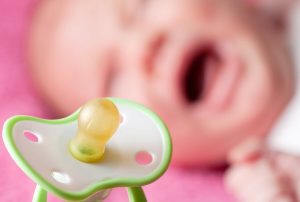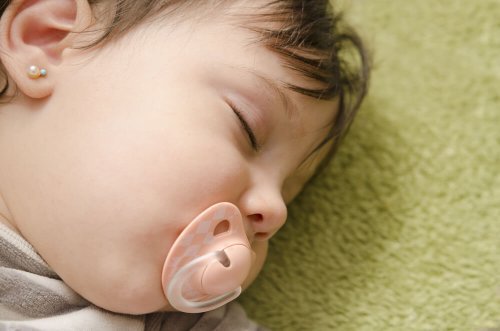Tips for Taking Away Your Baby's Pacifier

When it comes to taking away your baby’s pacifier, the first thing you should know is that there’s no perfect formula. However, in this article we’ll give you some tips. Hopefully, they’ll make this transition easy for you and your baby.
Certainly, if you’re planning to wean your baby off the pacifier, you don’t need to start in advance.
Also, make sure it doesn’t coincide with a big event. Some examples are a big move or a sibling being born. It’s best to take large events step by step to minimize your child’s stress.
Without a doubt, the sooner you stop giving your baby the pacifier, the easier it will be. Don’t forget that after 12 months, babies are more reluctant to change certain habits.
Like any other addiction, you can treat your child’s dependency on his pacifier by taking it away progressively. This can make the process a little easier, both for you and your little one.
If your attempts are initially unsuccessful, don’t panic. Also, don’t add extra stress or pressure on the baby. Remember, this tantrum isn’t a reflection of your abilities as a mother.
When the time is right, he’ll eventually give up. Meanwhile, try to relax. There are worse problems than this one.
We’ll tell you some ways to wean babies off of their pacifier below.
Tips for taking away your baby’s pacifier
Here are some tips that will help when it comes time for taking away your baby’s pacifier. We’re sure you’ll get it!
1. Use imagination
Childhood is a magical time. Therefore, it’s the perfect time to use your imagination to take away the pacifier. Taking advantage of this moment, you can make effective and creative strategies to change this habit.

For example, you can play make-believe with your baby. You can pretend there’s a magic fairy that comes at night to collect all the pacifiers.
In exchange, they’ll leave a small gift. This little game will motivate your baby to go along with the transition. It’ll also help him build his imagination.
2. Reduce pacifier time progressively
Secondly, we recommend reducing the pacifier time gradually if you don’t want to stop altogether. This means you can start by only giving babies their pacifier at nap time or bedtime.
After a few weeks, you can start to stop offering it at nap time. Once your child gets used to napping without a pacifier, you can start doing the same thing at bedtime.
In addition, we recommend that you keep the pacifier hidden in your pocket. Increase the amount of time that you wait before giving it to your baby. After you notice that your child doesn’t get upset, you can try giving him a toy or comfort him with other gestures.
The sooner you decide to take away the pacifier, the easier it will be. After 12 months, the baby will become more unwilling to change certain habits.
3. Try to calm your baby in other ways
It’s possible that, for the first few times you take it away, you’ll need to calm him in other ways. You can rock him, sing to him, or give him a gentle massage.
The goal is clear: to relieve discomfort and help your baby calm down without a pacifier. In this sense, you can also use soft blankets or a stuffed animal. Surely, these methods will work!

4. Tell everyone that takes care of your baby
Finally, it’s important that all of your baby’s caregivers know your plans. This means that, at home or in the nursery, they should know so they don’t confuse the child.
All in all, remember that these tips can help you wean your baby off of the pacifier. However, every child is different. Not all methods work for all babies.
It’s important to be patient and determined. Don’t worry too much. With this list of tips, you’ll surely reach your goal!
When it comes to taking away your baby’s pacifier, the first thing you should know is that there’s no perfect formula. However, in this article we’ll give you some tips. Hopefully, they’ll make this transition easy for you and your baby.
Certainly, if you’re planning to wean your baby off the pacifier, you don’t need to start in advance.
Also, make sure it doesn’t coincide with a big event. Some examples are a big move or a sibling being born. It’s best to take large events step by step to minimize your child’s stress.
Without a doubt, the sooner you stop giving your baby the pacifier, the easier it will be. Don’t forget that after 12 months, babies are more reluctant to change certain habits.
Like any other addiction, you can treat your child’s dependency on his pacifier by taking it away progressively. This can make the process a little easier, both for you and your little one.
If your attempts are initially unsuccessful, don’t panic. Also, don’t add extra stress or pressure on the baby. Remember, this tantrum isn’t a reflection of your abilities as a mother.
When the time is right, he’ll eventually give up. Meanwhile, try to relax. There are worse problems than this one.
We’ll tell you some ways to wean babies off of their pacifier below.
Tips for taking away your baby’s pacifier
Here are some tips that will help when it comes time for taking away your baby’s pacifier. We’re sure you’ll get it!
1. Use imagination
Childhood is a magical time. Therefore, it’s the perfect time to use your imagination to take away the pacifier. Taking advantage of this moment, you can make effective and creative strategies to change this habit.

For example, you can play make-believe with your baby. You can pretend there’s a magic fairy that comes at night to collect all the pacifiers.
In exchange, they’ll leave a small gift. This little game will motivate your baby to go along with the transition. It’ll also help him build his imagination.
2. Reduce pacifier time progressively
Secondly, we recommend reducing the pacifier time gradually if you don’t want to stop altogether. This means you can start by only giving babies their pacifier at nap time or bedtime.
After a few weeks, you can start to stop offering it at nap time. Once your child gets used to napping without a pacifier, you can start doing the same thing at bedtime.
In addition, we recommend that you keep the pacifier hidden in your pocket. Increase the amount of time that you wait before giving it to your baby. After you notice that your child doesn’t get upset, you can try giving him a toy or comfort him with other gestures.
The sooner you decide to take away the pacifier, the easier it will be. After 12 months, the baby will become more unwilling to change certain habits.
3. Try to calm your baby in other ways
It’s possible that, for the first few times you take it away, you’ll need to calm him in other ways. You can rock him, sing to him, or give him a gentle massage.
The goal is clear: to relieve discomfort and help your baby calm down without a pacifier. In this sense, you can also use soft blankets or a stuffed animal. Surely, these methods will work!

4. Tell everyone that takes care of your baby
Finally, it’s important that all of your baby’s caregivers know your plans. This means that, at home or in the nursery, they should know so they don’t confuse the child.
All in all, remember that these tips can help you wean your baby off of the pacifier. However, every child is different. Not all methods work for all babies.
It’s important to be patient and determined. Don’t worry too much. With this list of tips, you’ll surely reach your goal!
All cited sources were thoroughly reviewed by our team to ensure their quality, reliability, currency, and validity. The bibliography of this article was considered reliable and of academic or scientific accuracy.
- Asociación Española de Pediatría. Uso del chupete y lactancia materna. 2011. Disponible en: https://www.aeped.es/comite-lactancia-materna/documentos/uso-chupete-y-lactancia-materna
- Álvarez Hernández, C., Barcia Varas, J., Pavez Gallegos, N., & Zúñiga Delgado, C. (2015). Descripción de reflejos orofaciales, succión nutritiva y no nutritiva en lactantes prematuros extremos de 3 y 6 meses de edad corregida. http://repositorio.uchile.cl/bitstream/handle/2250/138230/Álvarez%20Barcia%20Pavez%20Zúñiga.pdf?sequence=1&isAllowed=y
- Diaz Coronado, V. N. (2018). EFICACIA DEL USO DEL CHUPETE EN LA DISMINUCIÓN DE LA MUERTE SÚBITA EN LACTANTES. http://repositorio.uwiener.edu.pe/bitstream/handle/123456789/2026/ESPECIALIDAD%20-%20Diaz%20Coronado%2c%20Vilma%20Nerida.pdf?sequence=1&isAllowed=y
- Asociación Española de Pediatría. (n.d.). Chupere. https://enfamilia.aeped.es/edades-etapas/chupete
- Varas, V. F., & Gil, B. G. (2012, December). Hábito de succión del chupete y alteraciones dentarias asociadas. Importancia del diagnóstico precoz. In Anales de Pediatría (Vol. 77, No. 6, pp. 374-380). Elsevier Doyma. https://www.google.com/url?sa=t&rct=j&q=&esrc=s&source=web&cd=&cad=rja&uact=8&ved=2ahUKEwir6Ijqxv_rAhUF2uAKHd25C2MQFjACegQIBRAB&url=https%3A%2F%2Fwww.analesdepediatria.org%2Findex.php%3Fp%3Drevista%26tipo%3Dpdf-simple%26pii%3DS1695403312001518&usg=AOvVaw34bQh3N6vKYwbb2nh6idzq
- Sánchez, L. M., González, E. D., Florensa, S. G. T., & Marti, J. G. (2000, January). Uso del chupete: beneficios y riesgos. In Anales de Pediatría (Vol. 53, No. 6, pp. 580-585). Elsevier Doyma. https://www.analesdepediatria.org/es-pdf-S1695403300775023
This text is provided for informational purposes only and does not replace consultation with a professional. If in doubt, consult your specialist.








